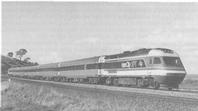


Chapter 7
I The First 100 Years 1788-1888
II Railways
i Location of the Railway
ii Track
iii Bridging and Tunnelling
iv Dams for Engine Water
v Locomotives and Rolling Stock
vi Signalling and Telecommunications
vii 1900/1988-The New Century
viii The Garratt Locomotive
ix Steam Locomotive Practice
x Motor Railcars
xi Signalling
xii Electric Tramways
xiii Electric Railways - Direct Current
xiv Electric Railways - 25 kV ac
xv Diesel Traction
xvi Alignment and Track
xvii Operations
III Motorised Vehicles
IV Aviation
V Modern Shipping
VI Innovative Small Craft
VII Conclusion
VIII Acknowledgements
IX Contributors
References
Index
Search
Help
Contact us

Over the years many schemes were put forward as to how best to solve the problem of break-of-gauge. Some, proposing conversion of entire railway systems to standard gauge (the gauge most favoured by railwaymen) were ruled out because of the exorbitant cost. Some positive steps were, however, taken as a result of some of these plans. Thus, in 1930 standard gauge lines were completed from the New South Wales border to South Brisbane and, in 1962, from Wodonga, on the New South Wales-Victoria border, to Melbourne.[3]
This meant that Brisbane, Sydney and Melbourne were connected by a line of common gauge, a most important development. Between Melbourne and Adelaide there existed a broad gauge line. A traveller proceeding to Perth would continue on a broad gauge line to Port Pirie and there change to the standard gauge of the Commonwealth Railway. At Kalgoorlie, for completion of his journey, he would change trains again, to the narrow gauge railway operated by the Western Australian Government Railways.
To do away with these irritating breaks-of-gauge and to give as direct an east-west service as possible, it was decided to plan for a standard gauge line between Sydney and Perth, via Broken Hill. This required the co-operation of the Australian Government and the Governments of New South Wales, South Australia and Western Australia.
Fortunately, of the 3,961 km Sydney-Perth line, 2,907 km were already of standard gauge. These were between Sydney and Broken Hill and between Port Pirie and Kalgoorlie.
The remaining two links of the proposed trans-continental line, i.e. between Broken Hill and Port Pirie, and between Kalgoorlie and Perth, were both of narrow gauge. These lines were re-laid to standard gauge, with some new track added.
Today, gauge as such has little affect on a railway's technology, capability or line capacity. Even in the early days there was nothing to choose, on a functional basis, between the 1435 mm (standard) gauge of N.S.W, and the 1600 mm (broad) gauge of Victoria and S.A. There was a significant difference, however, between the last century's 'wide' gauges and the 'narrow' gauge of 1067 mm adopted as the State standard for Queensland, W.A. and parts of S.A., as in these early days low constructional standards (cross section, alignment and axle loads -determined by track and bridge strength) were set to obtain the maximum km of rural railway access within finite loan funds. In contrast, with today's technology Queensland is operating on 1067 mm gauge the longest (148 car), heaviest (10600 t) and most powerful (six diesels of 1680 kw) trains of any government system, and plans to operate at 160 km/h on the new Gold Coast line, i.e. as fast as the XPT in N.S.W, on 1435 mm (Fig. 3).

The inconvenience of break-of-gauge for inter-system traffic lead to progressive gauge standardisation of these links from Sydney to Brisbane (1930), Melbourne (1962), Perth (1973) and finally Adelaide (1983).
Organisations in Australian Science at Work - Commonwealth Railways; Trans Australia Railway
People in Bright Sparcs - Macfarlane, Ian B.
 |
Australian Academy of Technological Sciences and Engineering |  |
© 1988 Print Edition pages 460 - 461, Online Edition 2000
Published by Australian Science and Technology Heritage Centre, using the Web Academic Resource Publisher
http://www.austehc.unimelb.edu.au/tia/449.html